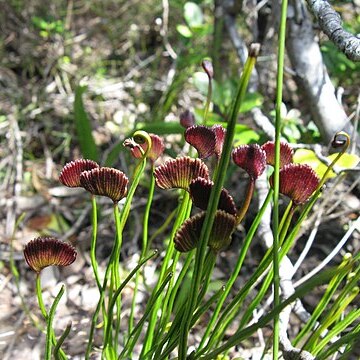Rhizome subterranean, short-creeping or ascending, clothed with brown hairs, bearing few to many slender fibrous roots. Fronds clustered, dimorphic. Stipe barely distinguishable from lamina, but usually brown. Lamina undivided or 1 to many times dichotomously branched, more rarely broad and leafy; veins free. Sporogenous fronds similar, but branches terminated by a pectinate, sporogenous head of pinnately arranged, usually folded segments. Sporangia borne in 2 rows along the segments on either side of the midrib and protected (when immature) by reflexed lobe margins which are often fringed by teeth or hairs. Spores smooth or variously ornamented. Gametophytes subterranean or terrestrial, filamentous, or a modified filamentous or pseudoaxial type, chorophyllous or non-chlorophyllous.
Plants terrestrial. Roots blackish, very narrow, tangled, practically glabrous. Stems upright to reclining; hairs few celled, uniseriate. Leaves all fertile or dimorphic with some sterile, lacking blades, mainly unbranched, long-petioled. Fertile blades folded and fistlike or pectinate, pinnate, segments (digits) arising along rachis on distal 3--10 mm; sterile leaves straight or often curling. Sporangia in 2 rows. Gametophytes growing mixed with mosses, green (photosynthetic), delicately filamentous, lacking hairs. x = 77, 94, 103.
Rhizome erect; lvs borne spirally, circinate in vernation, the sterile simple and linear, the fertile with several apical pairs of segments; sporangia sessile, protected by the incurved, long-ciliate lf-margin, erect or slightly bent, the annulus terminal; spores bilateral; gametophyte filamentous. 30, ± cosmop.
Plants evergreen, small. Rhizome siphonostelic, creeping or suberect, covered with septate hairs. Fronds linear and grasslike, or dichotomously branched and fan-shaped. Sporangia borne in 2-4 rows on extended fertile sporophores; spores monolete; gametophytes filamentous, algae-like.
Sporangia sessile in two rows on final, us. approximate, segs of lamina; spores bilateral. Rhizome short, stout, emitting clusters of slender erect fronds with narrow laminae at apex of stipes or its branches. Genus widespread, of about 30 spp.

